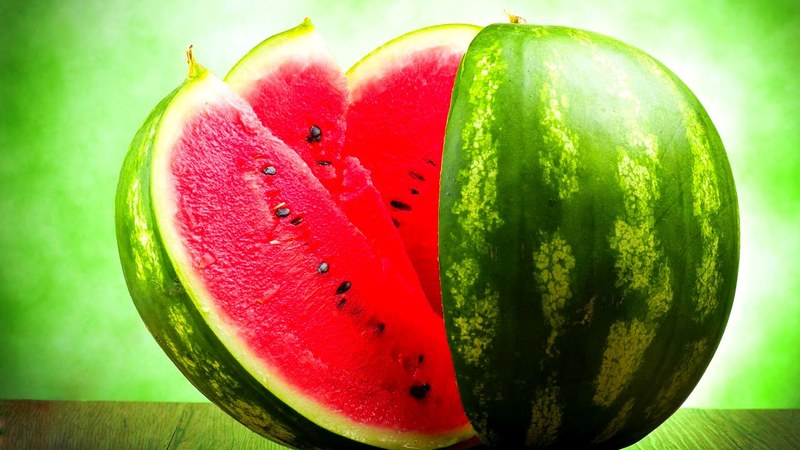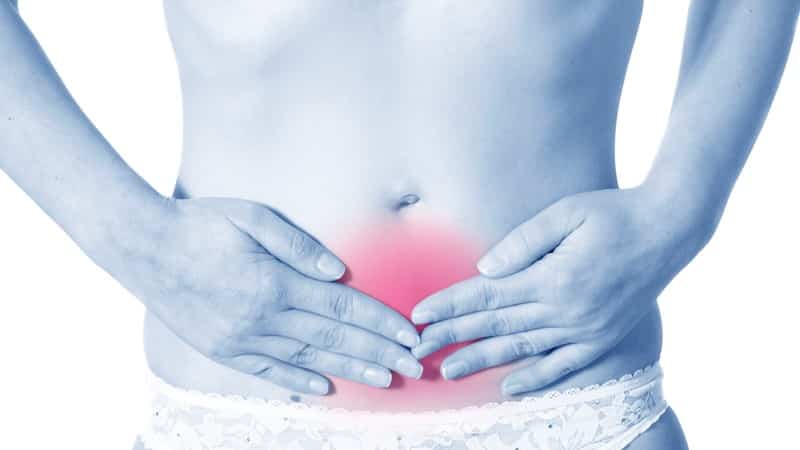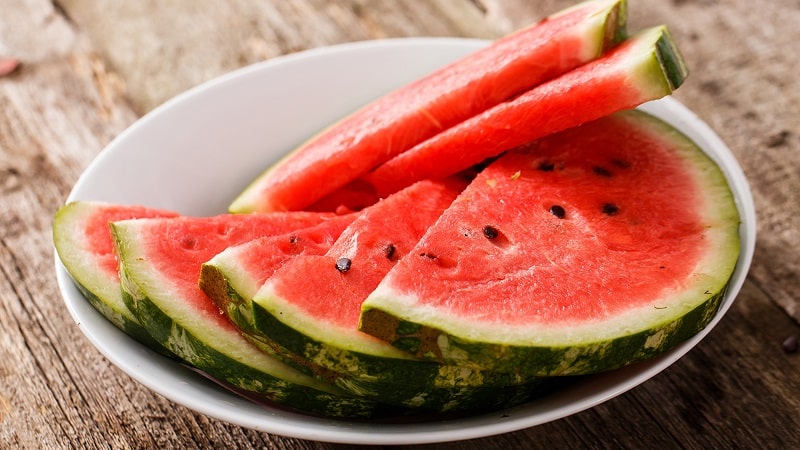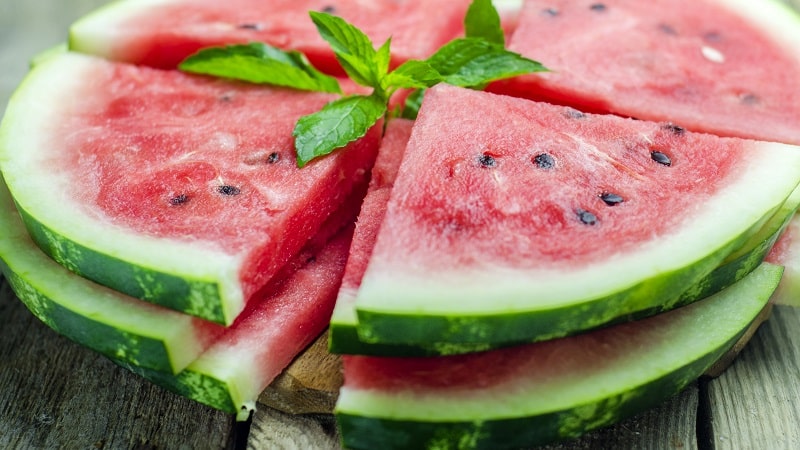How to eat watermelon for cystitis: how much you can eat during the day
Cystitis is a genitourinary infection that is characterized by painful urination and frequent urge. To begin treatment, you need to be examined by a doctor and receive recommendations on taking medications. Traditional medicine recommends consuming watermelon when this disease appears.
Read more in the article about whether it is possible to eat watermelon if you have cystitis and what contraindications exist for its consumption.
Chemical composition, trace elements and calorie content of watermelon
100 g of watermelon contains only 30 kcal, which means it will not affect your figure in any way. However, you should be more careful, because it contains a lot of sugars, and fructose is dangerous for patients with diabetes.
The list of vitamins and microelements in the composition is impressive (A, vitamins B, C, E, PP and H, magnesium, potassium, iron and calcium), but they contain small amounts. Watermelon lowers cholesterol, but most importantly, it contains almost 90% water. It is this feature that helps the functioning of the kidneys and genitourinary system.

Beneficial features
Watermelon enhances kidney function and causes increased urination, which helps remove cystitis pathogens from the mucosal walls.
In addition, striped berry:
- strengthens the nervous system, fights stress;
- eliminates not only inflammation of the bladder, but also the intestinal mucosa;
- quickly removes fluid from the body, relieving swelling;
- strengthens the immune system;
- relieves intoxication and lowers body temperature to normal;
- saturates with energy;
- creates a destructive environment for bacteria during genitourinary infections;
- reduces the likelihood of stone formation in the gall bladder and kidneys.
Can I use it if I have cystitis?
For cystitis, watermelon is the first means of concomitant treatment. This product is especially useful when prescribing antibiotics. But before you start using it, you need to consult your doctor.

In the acute stage
In order for cystitis to pass the acute stage faster, you should immediately start watermelon treatment:
- eat at least 1 kg of pulp per day, preferably in equal portions, so that urine is excreted gradually;
- cut off as much watermelon as you can eat at a time, do not store sliced;
- eat the berries separately from the rest of the food, taking a break of at least two hours;
- do not eat it before bed;
- reduce salt intake, or better yet, eliminate it for a while.
For chronic cystitis
If cystitis has reached the chronic stage, you can use watermelon juice to wash the urethra. During this period, watermelon is consumed according to the same rules as in the acute stage. They start with a small portion, for example, on the first day they eat 300 g, on the second they increase the portion to 600 g of pulp.
Attention! Cystitis can be treated with watermelon for about 7 days. However, after improvement, the striped berry is eaten for another 2-3 days to avoid relapse.
The effect of watermelon on cystitis
Patients often note an improvement in their condition after eating watermelon.
Important! You should buy quality products from trusted sellers. Fruit with nitrates will only cause harm.
Can watermelon provoke cystitis or transfer a chronic disease to an acute stage? No, the effect of the fetus is precisely to wash out pathogenic microflora from the body; it does not have time to multiply.This effect cannot cause the development of the disease.
Positive

Thanks to watermelon, a person consumes more water - it makes up almost 90% of the pulp of the striped berry. This stimulates the kidneys, speeds up the genitourinary system, watermelon juice cleanses the ducts and accelerates the removal of harmful microorganisms from the bladder.
Due to the fact that there is more water in the body, taking antibiotics does not cause much harm - the berry reduces the negative effects of chemicals.
The berry is most useful for acute forms of cystitis, which is accompanied by fever, since the pulp of the fruit relieves intoxication and normalizes temperature.
For any disease, it is important not to make the body worse and to cure it without consequences. Watermelon is a natural product that naturally removes microorganisms that cause inflammation of the genitourinary system.
Negative
If there are no contraindications, watermelon cannot harm the body with cystitis. However, if allergies or diarrhea, as well as swelling, pain, or other body reactions occur, you should immediately stop eating the berries. Then you will have to look for another method of concomitant alternative treatment or use exclusively medicinal methods.
Methods and norms of use

When consuming watermelon for cystitis, you should follow the recommendations:
- Start consumption with a minimum amount of 200 g per day;
- consume no more than 2 kg of fruit pulp per day;
- during pregnancy - no more than 200 g per day;
- divide the product into 4 equal parts;
- eat pulp separately from main meals;
- duration of treatment – more than 7 days;
- after eating the fruit, go to bed only 3 hours later;
- Do not eat stale fruits; at the slightest sign of spoilage, throw away the berries.
Contraindications
A doctor may prohibit the use of watermelon to treat cystitis in some cases:
- Diabetes. The reason is the high content of glucose and fructose in the berry.
- Pancreatitis, gastritis and cholecystitis. The juice of the fruit causes irritation to the organs of the digestive system if they are in the stage of inflammation or in a chronic form.
- Tendency to edema for various reasons, including kidney disease.
- Digestive system disorders. Watermelon can easily cause diarrhea and, in some cases, vomiting.
- Urolithiasis disease. Watermelon juice will cause the stones to move, causing severe pain.
- Pregnancy, if it is accompanied by swelling, diarrhea, especially after eating striped berries in the third trimester.
- BPH. The pain may intensify significantly, especially when urinating.
- Allergy to watermelon.
Watermelon Not recommended for use by children under three years of age due to the danger of nitrate content. The body may react unexpectedly to a new product, causing an eating disorder or allergy.
This is interesting:
Effective treatment: how to properly use dill seeds for cystitis.
Is it possible to eat melon with cholecystitis and cholelithiasis?
Is it possible to eat watermelon with cholecystitis and pancreatitis?
Conclusion
For cystitis, watermelon will be a useful addition to treatment, and in the acute stage it will help the body recover faster after taking antibiotics. They consume the pulp in an amount of no more than 2 kg per day, starting with 200 g - this makes it easier for the body to get used to it.
Before using this berry as a treatment for cystitis, you should definitely consult your doctor and rule out possible contraindications.